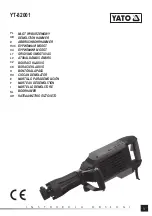
11
PM 728V-T v2 2020-10
Copyright © 2020 Quality Machine Tools, LLC
MOVING THE TABLE & HEADSTOCK
Conventionally, left-right movement of the table is said to be
along the X-axis (also called “longitudinal travel” or “travers-
ing”). Leadscrew handwheels are provided at both ends of the
table, Figure 3-7. Front-to-back movement is along the Y-axis,
sometimes called “cross travel”. The Y axis leadscrew has a
single handwheel at the front, Figure 3-8.
Headstock motion is in the Z-axis, in line with the vertical col-
umn. The headstock is raised and lowered by a handwheel at
top right of the column, Figure 3-9.
Figure 3-10
X-axis locks
Figure 3-11
Y-axis lock
When possible, operations calling for precise
depth control (such as milling) should be done
with the headstock locked, also with the quill
fully retracted
into the headstock and locked.
Figure 3-12
Z-axis lock (1)
Also shown here (2) is one of two headstock attachment nuts.
Figure 3-7
X-axis handwheel & dial (right hand)
Figure 3-8
Y-axis handwheel & dial
Figure 3-9
Z-axis handwheel & dial
LOCKING THE AXES
Before machining a workpiece it is usually necessary to po-
sition the table precisely, then lock either the X or the Y axis,
sometimes both (for drilling and similar operations). You can
also use the lock levers to apply a
light
drag to the axis in
motion. This can help reduce chattering (better surface finish)
and also lessen the chance of overshooting inadvertently. To
reduce wear, free the levers once the operation is completed.
Each axis has a leadscrew with handwheel and graduated dial
with 0.001” divisions, 0.1” per revolution, Figures 3-7 to 3-9.
If the mill is not equipped with digital readouts (DROs), the
table and headstock can be accurately positioned by count-
ing whole turns and divisions, keeping
leadscrew backlash
in mind. This means that motion must always be in the same
direction up to the point of reference, then on to the desired
location, see “Positioning by Counting X-Y Divisions”, later in
this section.
2
1










































